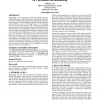Free Online Productivity Tools
i2Speak
i2Symbol
i2OCR
iTex2Img
iWeb2Print
iWeb2Shot
i2Type
iPdf2Split
iPdf2Merge
i2Bopomofo
i2Arabic
i2Style
i2Image
i2PDF
iLatex2Rtf
Sci2ools
AVI
2004
2004
Scaffolding visually cluttered web pages to facilitate accessibility
Increasingly, rich and dynamic content and abundant links are making Web pages visually cluttered and widening the accessibility divide for the disabled and people with impairments. The adaptations approach of transforming Web pages has enabled users with diverse abilities to access a Web page. However, the challenge remains for these users to work with a Web page, particularly among people with minimal Web experience and cognitive limitations. We propose that scaffolding can allow users to learn certain skills that help them function online with greater autonomy. In the case of visually cluttered Web pages, several accessibility scaffoldings were created to enable users to learn where core content begins, how text flows in a part of a Web page, and what the overall structure of a Web page is. These scaffoldings expose the elements, pathways, and organization of a Web page that enable users to interpret and grasp the structure of a Web page. We present the concept of an accessibility ...
| Added | 30 Oct 2010 |
| Updated | 30 Oct 2010 |
| Type | Conference |
| Year | 2004 |
| Where | AVI |
| Authors | Alison Lee |
Comments (0)

